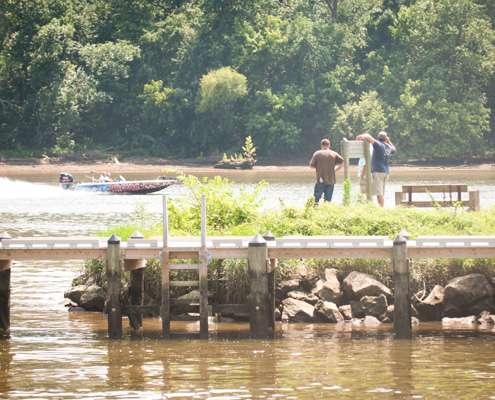
The anglers who showed up for this week’s Bass Pro Shops Bassmaster Northern Open on the James River in deep-hulled boats that excel on the Great Lakes were in for a rude awakening. The bass of the James aren’t tall and they don’t need a lot of headroom either, so super-shallow water is key.
“They just don’t get deep here on the James,” said former Bassmaster Classic winner David Fritts, who cranked and wormed his way to a 12-09 limit that has him in 10th place after Day One. He favors diving plugs that hit the bottom in 12-, 15- or even 20-feet of water, but those lures would just dig trenches through the mud in the areas he fished today. He said that he’d consider six feet to be deep on the James.
While water depth is one piece of the puzzle, the water levels rise and fall constantly, two full cycles a day, and that means that even the best spots go through unproductive periods. An angler can fish around the bass to win the tournament, but if he isn’t there at the right times he might as well have slept in and toured Colonial Williamsburg or Jamestown instead of fishing.
Tournament leader Kelly Pratt fishes dozens of tournaments every year on the James and its tributaries so he knows that running and gunning is a way of life. He said that he’s fishing the same areas as other anglers, but it’s the order of his milk run that makes the difference.
“If you show up 10 minutes too early you’re not going to catch them,” Pratt said. “And if you show up 10 minutes too late you’re not going to catch them.”
Ohio pro Charlie Hartley, a veteran of the similarly shallow but comparatively bass-poor Ohio River, is in 28th place with 9-12. Quite a few other competitors are fishing the same areas, but he said his home water experience benefitted him.
“It helps as far as getting used to fishing behind boats,” he said. “Some other guys, it freaks them out. I tried for years to get away from it all, but when you find a spot where you’re alone, there’s usually a reason there’s no boats there. We’re all fishing docks in the same area and after the first hour they’ve all been fished.”
Hartley’s fear is being late to the party, but equal woe will befall the angler who leaves too late. This afternoon there was an exceptionally low tide and anglers had to time their exits carefully in order to get back to the Osbourne Landing weigh-in site on time. North Carolina pro Pat Golden, in 6th place with 13-14 said that has the tide receded over the course of the later hours he had to “leave some fish biting to get ahead of them.” That could bode well for him tomorrow. While others may have depleted their best areas, he believes that the six areas he fished today, including two that he had to himself, should replenish overnight.
Had South Carolina pro Michael Murphy waited any longer in his best areas, he might’ve had a bigger bag, but he might’ve been stuck in the tidal gut where he caught them. He reported that as he approached the area of his egress, he “could see water rippling over mud.” His motor might’ve gotten a little clogged, but he made it back on time and sits in 42nd with 8-04.
Elite Series pro Nate Wellman wasn’t so lucky. At about 1:30, he ran across a skinny flat to get into an area, bumped a couple of stumps and ripped off his rear transducer. Over the course of the day he also managed to knock off his front transducer and broke two rods. “At least the boat’s not leaking,” he said, apparently preferring to see the glass as half-full – or the tide as halfway up, as the case may be. With only two fish for 2-07, he would seem to be too far outside of the cut to make up the necessary ground to fish on Saturday.
Tomorrow’s tides will be one hour later and that brings a new set of challenges for even the best fisherman. But even if the tides were exactly the same, other conditions might reposition the fish or change their attitude. For example, the areas where Fred Roumbanis caught quality fish in 12 inches of water on Wednesday were virtually dry even on higher tides today.
With margins between the haves and the have-nots narrow today, the room for error is minimal. If a competitor makes one mistake – whether it involve poor timing or running in a dangerous area – he can likely kiss his chances of making the cut, let alone winning, goodbye.

